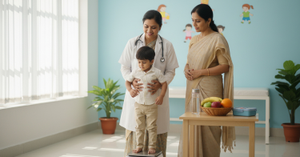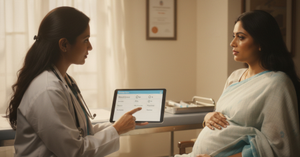“Why does my child always complain of stomach pain after eating?” is a question many parents ask during pediatric visits. While mild and occasional stomach aches are common in school-age children, frequent post-meal discomfort may point toward underlying gastrointestinal or systemic issues.
Children aged 5–10 often lack the vocabulary to explain what they’re feeling, so it’s crucial to interpret patterns, triggers, and accompanying symptoms.
1. Persistent or Daily Post-Meal Pain
Red Flag:
If your child regularly complains of abdominal pain within 30–60 minutes of meals, and it lasts for more than 2–4 weeks, it could indicate something more than just overeating or gas.
Possible causes:
- Functional dyspepsia
- Gastritis or reflux disease (GERD)
- Gallbladder issues
- Pancreatic enzyme deficiency
When to seek help:
If the pain is upper abdominal, worsens after fatty meals, or interferes with school or play, evaluation is needed.
2. Pain with Weight Loss or Poor Growth
Red Flag:
Any gastrointestinal symptoms accompanied by slowed growth, visible weight loss, or stagnation on the growth chart should never be ignored.
Possible diagnoses:
- Celiac disease
- Inflammatory bowel disease (IBD)
- Chronic malabsorption (e.g., lactose intolerance, pancreatic insufficiency)
Diagnostic tests:
- Growth monitoring and BMI-for-age percentile
- Blood tests: CBC, iron studies, anti-tTG for celiac
- Stool analysis for fat content and inflammatory markers
3. Abdominal Pain with Diarrhea or Blood in Stool
Red Flag:
Pain after eating that is followed by loose stools, urgency, or visible blood is a significant clinical concern.
Likely conditions:
- Infective colitis
- Food allergies (e.g., dairy, egg, wheat)
- Ulcerative colitis or Crohn’s disease
Clinical insight:
The presence of blood in stool, whether bright red or dark, requires prompt investigation, even if the child appears otherwise well.
4. Recurring Pain in the Same Location
Red Flag:
Pain that localizes consistently in one part of the abdomen (e.g., lower right or upper left) may point toward organ-specific conditions.
Examples:
- Upper right: Gallbladder disease
- Lower right: Appendiceal irritation or Meckel’s diverticulum
- Upper middle: GERD, peptic ulcers
- Around the navel: Functional abdominal pain (most common but diagnosis of exclusion)
Assessment tip:
Palpation during physical exam and the child’s ability to point accurately to the area help in narrowing the differential diagnosis.
5. Night-Time or Sleep-Disturbing Pain
Red Flag:
Stomach aches that wake a child from sleep or prevent them from falling asleep are more likely to be organic rather than functional.
Possible conditions:
- GERD
- Peptic ulcers
- Early appendicitis
- Constipation with fecal impaction
Why it matters:
Pain not influenced by distraction or activity is less likely to be behavioral or anxiety-driven and warrants further workup.
6. Post-Meal Nausea or Vomiting
Red Flag:
Nausea or vomiting that repeatedly follows meals is not normal in school-age children.
Differential diagnoses:
- Gastroesophageal reflux disease (GERD)
- Gastric outlet obstruction (rare)
- Cyclic vomiting syndrome
- Food poisoning or intolerance
Red-flag features to note:
- Projectile vomiting
- Vomiting bile or blood
- Vomiting with signs of dehydration or lethargy
7. Severe Bloating, Gas, or Burping After Meals
Red Flag:
Uncomfortable bloating, excessive burping, or visible distension after meals could indicate fermentative digestion or motility disorders.
Common causes:
- Lactose intolerance
- Fructose malabsorption
- Small intestinal bacterial overgrowth (SIBO)
- Aerophagia (swallowing air)
Action steps:
Maintain a symptom-food diary and discuss possible elimination diets under pediatric supervision.
8. Family History of Digestive or Autoimmune Diseases
Red Flag:
If a first-degree relative has a history of celiac disease, IBD, or peptic ulcers, the child is at higher risk for related conditions.
Why it matters:
Genetic predisposition influences not only susceptibility but also the age of onset and disease severity.
Suggested screenings:
- Anti-tissue transglutaminase (tTG) antibodies for celiac
- Calprotectin stool test for IBD
- H. pylori testing if ulcer symptoms are suspected
9. Behavioral Avoidance of Meals or School
Red Flag:
If the child starts avoiding certain meals, complains of pain to skip school, or has anxiety around eating, deeper issues may be involved.
Underlying issues:
- Chronic constipation
- Eating disorders (in older children)
- Anxiety-linked functional abdominal pain
- Fear of post-meal symptoms
Clinical guidance:
Repeated school absences due to stomach pain warrant psychosocial screening as well as medical evaluation.
10. Constipation-Linked Pain Mistaken for Other Illnesses
Red Flag:
Constipation in school-age children often presents with stomach pain after eating, mimicking other disorders.
How it causes pain:
Accumulated stool in the rectum or colon causes stretch and pressure, which worsens after meals due to the gastrocolic reflex.
Key signs:
- Large, infrequent stools
- Soiling or streaks in underwear
- Hard stools despite daily bowel movement
Management:
Regular toilet routine, hydration, and dietary fiber help, but prolonged cases may require medical treatment.
When to See a Pediatrician
Consult your child’s pediatrician if:
- Abdominal pain follows meals on most days of the week
- Symptoms last for more than 2–3 weeks
- Pain is associated with any of the above red flags
- Your child’s daily activities, growth, or appetite are affected
Early identification of red flags enables targeted interventions and reduces long-term gastrointestinal complications.
Conclusion
While mild stomach aches are common in school-aged kids and often harmless, persistent or meal-triggered pain may indicate a deeper issue. Understanding the red flags, such as poor growth, blood in stool, vomiting, or behavioral changes—helps differentiate functional pain from potentially serious gastrointestinal conditions. Parents should trust their instincts, document symptoms, and consult a pediatrician when warning signs appear.
References
- Rasquin-Weber A, et al. Childhood Functional Gastrointestinal Disorders. Gastroenterology. 2006;130(5):1527–1537.
- Hyams JS, Di Lorenzo C, Saps M, et al. Functional Abdominal Pain Disorders in Children. JPGN. 2016;63(1):e1–e26.
- Hill ID, et al. Guidelines for the Diagnosis and Treatment of Celiac Disease in Children. JPGN. 2005;40(1):1–19.
- Bousvaros A, et al. Differentiating IBD from Functional GI Disorders. Pediatrics. 2007;119(6):e1322–e1329.
- American Academy of Pediatrics. Chronic Abdominal Pain in Children: Clinical Report. Pediatrics. 2005;115(3):812–815.








Be the first one to comment on this story.